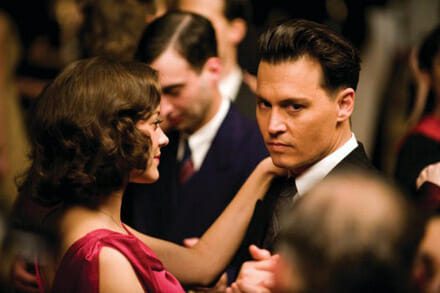
Release Date: July 1
Director: Michael Mann
Writers: Ronan Bennett and Michael Mann & Ann Biderman
Starring: Johnny Depp, Christian Bale, Marion Cotillard
Cinematographer: Dante Spinotti
Studio/Run Time: Universal Pictures, 140 mins.
20th Century gangsters through a 21st Century lens
Early reviewers are shrugging their shoulders at the new Michael Mann, Johnny Depp, Christian Bale film, Public Enemies, but it’s miles better than Terminator Salvation or any other gun-blazing film you could pick at random from the first half of the summer crop. It’s more entertaining, more thought provoking, and were it shot on film I bet it’d be more acclaimed.
But it wasn’t shot on film. It was shot on grotesque, cheap-looking video. It’s an odd choice for Mann and his cinematographer, Dante Spinotti, but if one assumes that they know how to create beautiful images when they want to—and the guy who shot L.A. Confidential and The Quick and the Dead surely knows his way around sepia tones—then using video is a strange and bold aesthetic choice. It says something, but what?
The light in this film is very often TV-ugly. Under the harsh gaze of reasonably advanced digital video, a man’s white collar in a dark room and the hi-beams of the car that he later drives into the night both exceed their boundaries, like a drop of bleach on black construction paper. Pale green leaves lose their edges against a light blue sky. Details of faces are exposed when the heavy make-up on the cheeks and foreheads of the film’s famous actors might be better hidden.
But another trait of these newfangled cameras is a remarkable field of vision. Several times Mann halves the screen with a close-up on one side and distant action on the other. Even in low light, the camera sees both sides in detail. And the most obvious and tempting trait of the technology is that, compared to the Panavision boat anchors that guys have been lugging for decades, these cameras are light as feathers.
Unlike some of his peers, Mann resists the temptations and holds such features in reserve, bringing them out like machine guns concealed under a wool topcoat. Public Enemies is shot and edited in a stable, classical style so that in those instances when the picture zips up a woman’s bare leg, or seeks purchase on the floor of a crowded club, or whips and zooms at a moment of discovery, it tells us that something important has happened: the modern world has seeped into an old story, or vice-versa. There’s more to the film than its technical details. It stars two of Hollywood’s strong leading men, actors of diametrically opposed styles, and they both take the job seriously. Depp isn’t impersonating any skunks or rock stars, and Bale isn’t shouting needlessly or speaking in an unusually low register. They’re acting, they’re doing it well, and I only wish they’d been able to share the screen instead of stewing and smirking in two counter-posed worlds. Depp is bank robber John Dillinger, on the lam, and Bale is FBI agent Melvin Purvis, on the hunt. Rarely, but inevitably, the twain shall meet.
The same could be said for Dillinger and his sweetheart Billie, a beautiful young woman, played by Marion Cotillard, whose sexy aura is only enhanced by a willingness to hitch her wagon to this gangster’s Ford Deluxe. She and Dillinger talk in a crowded, high-ceiling restaurant, but all the noise around them drops neatly away. For a moment, they float, just like in the movies. In a sense, that’s what the film is about: two bodies in a dance or in a tug of war that will eventually end in mud. Good guys vs. bad guys, sure, but also film vs. video, real life vs. the movies, free will vs. determinism, tainted glory vs. tainted glory.
We know from other films that gangsters love to see themselves on the screen. In an episode of The Sopranos, Tony sat down to watch James Cagney in The Public Enemy, and his guys were forever quoting Al Pacino in Godfather III. In this new film, Babyface Nelson performs his Cagney impression for an unreceptive, captive, scared-shitless audience. And in the finale, when Dillinger sees a movie at Chicago’s Biograph theatre, he grins up at Clark Gable who plays a gangster in Manhattan Melodrama. In real life, a black and white film doesn’t turn a theatre’s red velvet seats gray, but Mann drains the color from that room, blending the audience with the film, letting its silvery sheen blanket them and their fedoras like they’re the cast of an American tragic romance. Which, of course, they are. The mustache above Johnny Depp’s smirk matches Gable’s, even down to the slight tilt.
The story in Public Enemies has already been told, sometimes in films more exciting but rarely more thoughtful than this one. Purvis says he’s going to transform the FBI with new scientific methods and new technology, but technology can’t suppress human nature, and when he’s pressured Purvis resorts to beating confessions out of people like they did in the old days. With its application of visibly new technology, Public Enemies could nestle comfortably alongside Peter Watkins’ La Commune, a faux video report about a 19th century event, but this time it’s the style of an unperfected, 21st century medium that reveals the pancake make-up of its actors but also conveys a star-crossed romance that endures, in part because we associate it with a colorful era. Like the sexiness of a swagger and the unfortunate allure of torture, it’s timeless.
This may not be saying much, but for the first time this summer, the movies are back.